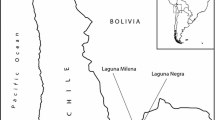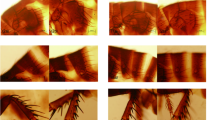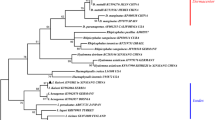Abstract
In a mountainous area in the Dinaric Beech-Fir Forest of southern Slovenia, summer nests of the European fat dormouse (Glis glis) were collected. From these dormouse nests, 180Monopsyllus sciurorum sciurorum fleas were examined by polymerase chain reaction with primers for theRickettsia citrate synthase gene. Samples from one nest yielded the expected 381 base pair DNA product. The origin of the DNA product was identified asRickettsia typhi byAluI restriction fragment length polymorphism analysis. Inoculation of the triturated positive fleas into Vero cell culture resulted in the cultivation of a rickettsia which reacted with polyclonal and species-specific monoclonal antibodies forR. typhi. The widespread distribution of this sylvatic flea species in nearly all of Europe as well as in the Middle East and its presence on other mammalian and avian hosts suggests thatR. typhi might exist in unrecognised enzootic cycles. Further investigations are needed to determine the extent of these cycles in Europe and the potential occurrence of human infections.
Similar content being viewed by others
References
Arango-Jaramillo S, Farhang-Azad A, Wisseman CL Jr. Experimental infection withRickettsia mooseri and antibody response of adult and newborn laboratory rats. Am J Trop Med Hyg 1984; 33: 1017–1025.
Farhang-Azad A, Traub R, Baqar S. Transovarial transmission of murine typhus rickettsiae inXenopsylla cheopis fleas. Science 1985; 227: 543–545.
Azad AF, Traub R. Experimental transmission of murine typhus byXenopsylla cheopis flea bites. Med Vet Entomol 1989; 3: 429–433.
Dobson ME, Azad AF, Dasch GA, Webb L, Olson JG. Detection of murine typhus infected fleas with an enzyme-linked immunosorbent assay. Am J Trop Med Hyg 1989; 40: 521–528.
Farhang-Azad A, Traub R, Sofi M, Wisseman Jr CL. Experimental murine typhus infection in the cat flea,Ctenocephalides felis (Siphonaptera: Pulicidae). J Med Entomol 1984; 21: 675–680.
Williams SG, Sacci JB Jr, Schriefer ME, Andersen EM, Fujioka KK, Sorvillo FJ, Barr AR, Azad AF. Typhus and typhuslike rickettsiae associated with opossums and their fleas in Los Angeles County, California. J Clin Microbiol 1992; 30: 1758–1762.
Farhang-Azad A, Traub R, Wisseman Jr CL.Rickettsia mooseri infection in the fleas Leptopsylla segnis and Xenopsylla cheopis. Am J Trop Med Hyg 1983; 32: 1392–1400.
Farhang-Azad A, Traub R. Transmission of murine typhus rickettsiae byLeptopsylla segnis (Siphonaptera: Leptopsyllidae). J Med Entomol 1985; 24: 689–693.
Azad AF. Relationship of vector biology and epidemiology of louse- and flea-borne rickettsioses. In: Walker DH, ed. Biology of rickettsial diseases, Vol 1. Boca Raton: CRC Press, 1988: 51–61.
Cobert G, Ovenden D. The mammals of Britain and Europe. Glasgow: Wm Collins Sons and Co, 1980, 247 pp.
Krystufek B. Sesalci Slovenije [Mammals of Slovenia]. Ljubljana: Prirodoslovni muzej Slovenije (Slovene Museum of Natural History), 1991, 294 pp.
Trilar T. Population density, biomass and reproduction of small mammals of the Dinaric beech-fir forest at Snežnik between 1988 and 1990. Master of Science Thesis, University in Ljubljana, Ljubljana, 1991, 84 pp.
Rosicky B. Fauna ČSR, Svazek 10: Blechy — Aphaniptera. Praha: Nakladatelstvi Československe Akademie Ved, 1957, 446 pp.
Brelih S. Ectoparasitical entomofauna of Yugoslav mammals, II,Siphonaptera from Dinaromys bogdanovi and Chionomys nivalis (Rodentia: Cricetidae). Scopolia 1986; 11: 1–47.
Southwood TRE. Ecological methods with particular references to the study of insect population. London/New York: Chapman and Hall, 1978, 524 pp.
Regnery RL, Spruill CL, Plikaytis BD. Genotypic identification of rickettsiae and estimation of intra-species sequence divergence for portions of two rickettsial genes. J Bacteriol 1991; 173: 1576–1589.
Philip RN, Casper EA, Burgdorfer W, Gerloff RK, Hughes LE, Bell EJ. Serologic typing of rickettsiae of the spotted fever group by microimmunofluorescence. J Immunol 1978; 121: 1961–1968.
Azad AF, Sacci JB Jr, Nelson WM, Dasch GA, Schmidtmann ET, Carl M. Genetic characterization and transovarial transmission of a typhus-like rickettsia found in cat fleas. Proc Natl Acad Sci USA 1992; 89: 43–46.
Dumler JS, Taylor JP, Walker DH. Clinical and laboratory features of murine typhus in South Texas, 1980 through 1987. JAMA 1991; 266: 1365–1370.
Silpapojakul K, Chupuppakarn S, Yuthasompob S, Varachit B, Chaipak D, Borkerd T, Silpapojakul K. Scrub and murine typhus in children with obscure fever in the tropics. Pediatr Infect Dis J 1991; 10: 200–203.
Artemiev MI, Ignatovich VF, Rydkina EB, Lichoded LJ, Balayeva NM, Demkin VV. Restriction fragment length polymorphism analysis of typhus group rickettsiae DNA. In: Kazar J, Raoult D, eds. Rickettsiae and rickettsial disease. Bratislava: Publishing House of the Slovak Academy of Sciences, 1991: 102–107.
Webb L, Carl M, Malloy DC, Dasch GA, Azad AF. Detection of murine typhus infection in fleas by using the polymerase chain reaction. J Clin Microbiol 1990; 28: 530–534.
Author information
Authors and Affiliations
Corresponding author
Rights and permissions
About this article
Cite this article
Trilar, T., Radulovič, S. & Walker, D.H. Identification of a natural cycle involvingRickettsia typhi infection ofMonopsyllus sciurorum sciurorum fleas from the nests of the fat dormouse (Glis glis). Eur J Epidemiol 10, 757–762 (1994). https://doi.org/10.1007/BF01719294
Accepted:
Issue Date:
DOI: https://doi.org/10.1007/BF01719294




